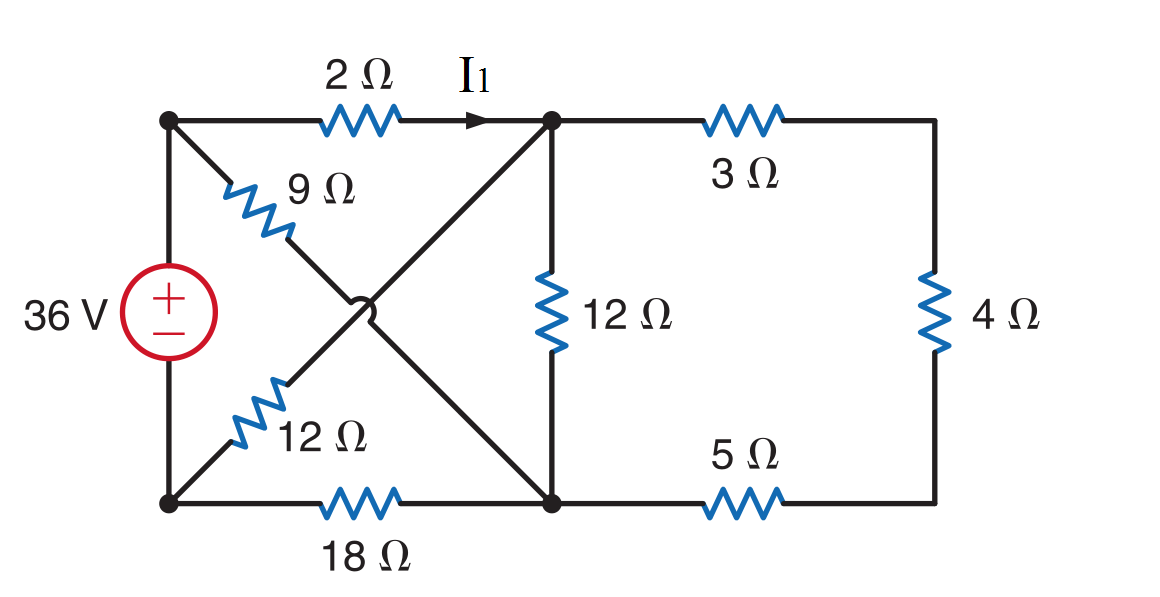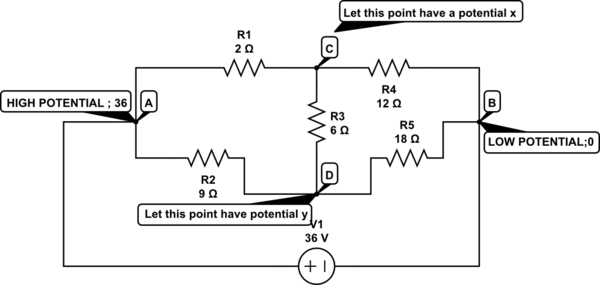
simulate this circuit – Schematic created using CircuitLab
First, convince yourself that the above re-drawn schematic is the same as your problem original. I may have the numbering off (actually, I certainly do have the numbering off), but it is the approach which is important.
So:
We can make a quick substitution by combining R4 to R6 as R9=12 ohms because they're in series. I probably could also reduce R9 and R3 in parallel, but I'll leave them as-is for now.
Next, write out KCL and Ohm's law (assume currents are flowing "down" through resistors, up through V0):
\begin{equation}
I_0 - I_1 - I_2 = 0\\
I_1 - I_3 - I_8 - I_9 = 0\\
I_2 - I_3 - I_7 - I_9 = 0\\
\end{equation}
\begin{equation}
I_1 = \frac{V_a - V_b}{R_1}\\
I_2 = \frac{V_a - V_c}{R_2}\\
I_3 = \frac{V_b - V_c}{R_3}\\
I_7 = \frac{V_c}{R_7}\\
I_8 = \frac{V_b}{R_8}\\
I_9 = \frac{V_b - V_c}{R_9}\\
V_a = V_0
\end{equation}
Substituting back in:
\begin{equation}
I_0 - \frac{V_a - V_b}{R_1} - \frac{V_a - V_c}{R_2} = 0\\
\frac{V_a - V_b}{R_1} - \frac{V_b - V_c}{R_3} - \frac{V_b}{R_8} - \frac{V_b - V_c}{R_9} = 0\\
\frac{V_a - V_c}{R_2} - \frac{V_b - V_c}{R_3} - \frac{V_c}{R_7} - \frac{V_b - V_c}{R_9} = 0\\
V_a = V_0
\end{equation}
A little bit of re-writing (Gn = 1/Rn):
\begin{equation}
I_0 + G_1 V_b + G_2 V_c = (G_1 + G_2) V_0\\
(G_1 + G_3 + G_8 + G_9) V_b - (G_3 + G_9) V_c = G_1 V_0\\
(G_3 + G_9) V_b - (G_3 - G_2 - G_7 + G_9) V_c = G_2 V_0
\end{equation}
We have three equations with three unknowns: I0, Vb, and Vc. Once you've solved for these you can calculate I1 easily using R1, Va, and Vb. And yes, this is a solvable system. I'll stop short of just posting the number solution.
Incidentally, this approach is known as Modified Nodal Analysis and is used in SPICE circuit simulation software. It basically adds an extra unknown current for each voltage source, and then adds an extra equation for the difference between the nodal voltages. I simply did some extra "inline plugging in" of the source voltage equation to reduce the set of equations/unknowns to 3. Yes, this approach might look like extra work because you are solving for voltages first, but it is a much more systematic approach, quite robust, and in the long run I find it faster to actually do.









